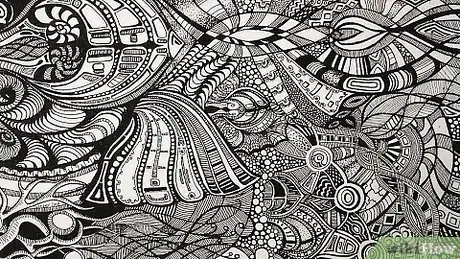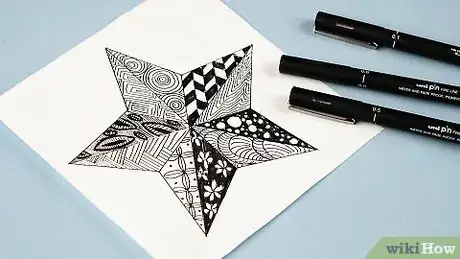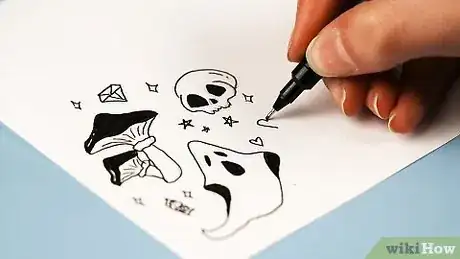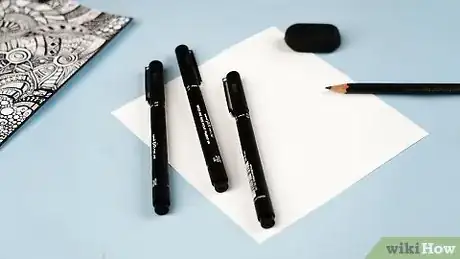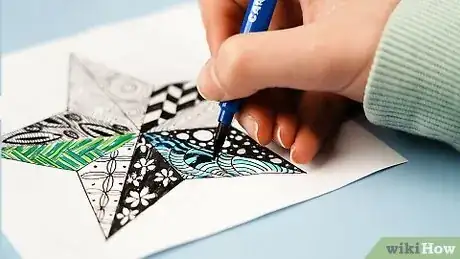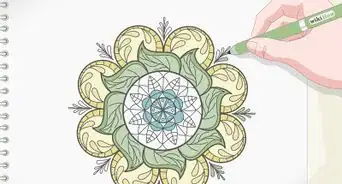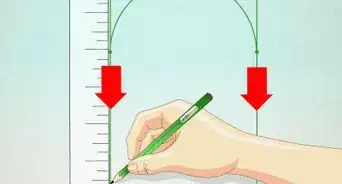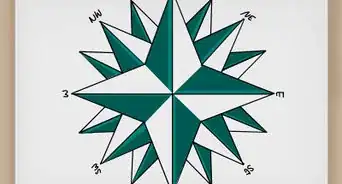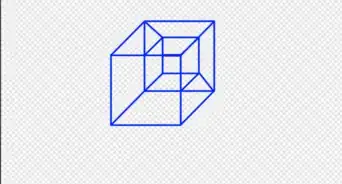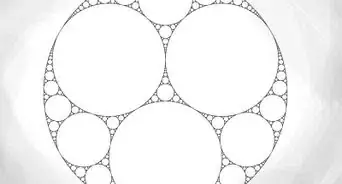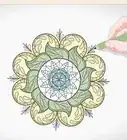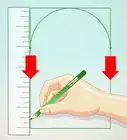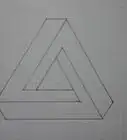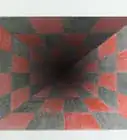This article was co-authored by Kelly Medford. Kelly Medford is an American painter based in Rome, Italy. She studied classical painting, drawing and printmaking both in the U.S. and in Italy. She works primarily en plein air on the streets of Rome, and also travels for private international collectors on commission. She founded Sketching Rome Tours in 2012 where she teaches sketchbook journaling to visitors of Rome. Kelly is a graduate of the Florence Academy of Art.
There are 7 references cited in this article, which can be found at the bottom of the page.
wikiHow marks an article as reader-approved once it receives enough positive feedback. This article has 43 testimonials from our readers, earning it our reader-approved status.
This article has been viewed 1,452,287 times.
A Zentangle drawing is an abstract drawing created using repetitive patterns according to the trademarked Zentangle Method. True Zentangle drawings are always created on 3.5 inch (8.9 cm) square tiles, and they are always done in black ink on white paper with grey pencil shading. The invention of the Zentangle® was intended to make the act of drawing pleasurable, meditative and accessible to all. See Step 1 to learn how to start creating your own Zentangle drawing.[1]
Steps
Learning About the Zentangle Method
-
1Learn the basic definition of a Zentangle. A Zentangle drawing is an abstract, patterned drawing created according to the tenets of the Zentangle Method. Using the standard format of a 3.5-inch square tile (means piece of square paper), the artist creates a structured pattern according to his or her whim following a basic set of guidelines.[2] No technology, special materials, or educational background are necessary to become a Zentangle artist. Here are a few characteristics of a Zentangle:
- The tile should not have an "up" or a "down" - it is without orientation.
- It should not be representative of any certain recognizable object; rather, it should be abstract.
- The drawing should be completed in black ink on white paper with gray pencil shading.
- A Zentangle is meant to be portable, so that it can be created at any time the mood strikes.[3]
-
2See how Zentangle is different from other art. The Zentangle Method is very different from regular drawing, painting and other art forms. It is meant to be a form of artistic meditation that anyone can do. The act of creating the Zentangle is just as important as the final outcome, which is appreciated for its unique beauty. Zentangle creations adhere to the following philosophical tenets:
- Its creation is unplanned. When you begin creating a Zentangle, you're encouraged not to have an end goal in mind. Rather, allow the pattern to reveal itself as you draw.
- Its creation of a Zentangle drawing is deliberate, yet unexpected. Each stroke should be made deliberately, rather than hesitantly. Instead of erasing stray marks, the artist should use them as the foundation for an unexpected pattern.
- Its creation is celebratory. Like meditation, the Zentangle Method is meant to feel freeing and healing. It's a way to celebrate the beauty of life.[4]
- A Zentangle is timeless. No technology or special tools are used. Zentangles should connect those who make them to the timeless human endeavor of putting pen to paper.
Advertisement -
3Understand the difference between a Zentangle and a doodle. Many people create doodles - sometimes beautiful ones - in the margins of notebooks and on scrap paper. Doodles are usually created during times when the person making them is having trouble paying attention to something else that's going on, like a lecture or a phone call. Though the best doodles can look similar to Zentangles, they're actually very different. Here's how:
- The Zentangle Method helps you create a feeling of relaxed focus. Unlike doodling, the person creating a Zentangle is giving it his or her full, undivided attention. A Zentangle cannot be created while on the phone or to let yourself be distracted during a lecture, because attention is an inherent part of this art form.[5]
- The Zentangle Method is a ceremony. Since a Zentangle deserves the artist's utmost attention. It should be created in a quiet place where focus and reverence can be achieved. The paper and pens used should be of highest quality, since a Zentangle is a work of art that can be enjoyed for a long time to come.
-
4Learn about the founding artists. The Zentangle Method was invented by Rick Roberts and Maria Thomas, when they discovered that the act of drawing abstract patterns with the constraint of a few basic rules was extremely meditative.
- In order to teach the Zentangle Method, one must be certified as a Zentangle Teacher.[6]
- There are over one hundred tangles (these are patterns) (re-)created by Zentangle. If you want to recreate one of the originals, there are tutorials online and books and kits available for purchase. Works that are reminiscent of the drawing method Zentangle but don't adhere to the official guidelines are referred to as Zentangle-inspired art.
Creating Your Own Zentangle
-
1Start with the right supplies. The Zentangle Method encourages using fine printmaking paper to use as a foundation for Zentangles. It should be plain white, unlined paper. Cut your paper into a 3.5" square piece.
- Handmade or textured paper is fine, as long as it doesn't have patterns.
- You can use colored paper if you want, but wouldn't be considered a true Zentangle according to the Zentangle Method.
-
2Draw a border. Use a pencil to draw a light square border around the edges of your paper. The pattern you make will be drawn inside the perimeters of the border. Do not use a ruler or any sort of straight edge to draw your border. Just sketch it lightly near the edges of the paper.
- It's completely fine if your hand wavers while you draw the border. The border will be a unique, original constraint inside which your pattern will emerge. If it has wavy lines or looks uneven, your finished Zentangle will be that much more original.
- Do not press down too hard with the pencil as you freehand the border. It is not meant to be visible once you finish creating your Zentangle in pen.
-
3Draw a string. Take your pencil and draw a "string" inside the border. According to the Zentangle Method, a string is a curved line or squiggle that will lend structure to your design. The pattern you create will emerge according to the contours of your string. It should a lightly-sketched, simple, abstract form that elegantly divides the border into sections.
- Again, don't press down too hard with your pencil as you draw the string. It will not be visible once your Zentangle is finished. It is meant to serve as a guide for your pattern.
- Some people find it hard to determine how to draw the string. Remember that the philosophy behind a Zentangle is that it should feel pleasurable, celebratory and natural. Draw whatever comes out when you touch your pencil to the paper - there's no wrong way to do it.
- If you want ideas for creating different strings, there are string patterns available online.[7]
-
4Start creating a tangle. A "tangle" is a pattern drawn in pen along the contours of a string. One Zentangle may have just one tangle, or a combination of different tangles. Use your pen to begin drawing whatever pattern comes to you - again, there's no right or wrong move inside a Zentangle. As you work, keep the following in mind:
- Tangles should be composed of very simple shapes. A line, a dot, a circle, a squiggle, or an oval are all acceptable.
- Penciled shading can be added to the tangles to create more depth and visual interest. This is not mandatory, but you're free to do so if you'd like.
-
5Don't erase mistakes. You can't erase mistakes you make in pen. That's part of the reason tangles are created in pen, not pencil, aside from any shading you might want to add. There's no going back.
- Every tangle is built stroke by stroke. Pay attention to each stroke you make, and build your pattern in a deliberate fashion.
- Focus intently on your work. Just as you would while meditating, free your mind of worries and problems. Remember that the act of creating a Zentangle should feel ceremonial.[8]
-
6Keep going until you're finished. You'll know when it's time to put down your pen. Keep your Zentangle in a safe place, or frame it and display it for long-term enjoyment.
-
7Add color(Optional). Once your tile is finished, you can add color to your art. However, please note that this is not part of the official Zentangle instructions.
Community Q&A
-
QuestionWhat if you don't know what to draw?
 Community AnswerThe idea is to let your pencil flow; the drawing isn't supposed be something you know how to do or something that you plan out: just go with it. Start with a line, a stroke, or even a simple shape and work your way from there. Don't worry about the end result!
Community AnswerThe idea is to let your pencil flow; the drawing isn't supposed be something you know how to do or something that you plan out: just go with it. Start with a line, a stroke, or even a simple shape and work your way from there. Don't worry about the end result! -
QuestionWhat kind of paper is recommended?
 Community AnswerFine printmaking paper in white is ideal, but you can play around with the different paper types.
Community AnswerFine printmaking paper in white is ideal, but you can play around with the different paper types. -
QuestionHow do you know what lines to draw or patterns?
 Community AnswerIt's not so much about knowing what to draw in advance as it is about being moved artistically through working on the drawing itself. However, it you're stumped, check out online images of other people's Zentangle designs for inspiration. Have faith in your ability: get started on drawing lines and patterns and see what comes forth!
Community AnswerIt's not so much about knowing what to draw in advance as it is about being moved artistically through working on the drawing itself. However, it you're stumped, check out online images of other people's Zentangle designs for inspiration. Have faith in your ability: get started on drawing lines and patterns and see what comes forth!
References
- ↑ https://zentangle.com/pages/about-the-zentangle-method
- ↑ https://zentangle.com/pages/what-is-the-zentangle-method
- ↑ http://www.zentangle.com/index.php?option=com_content&view=article&id=10&Itemid=120
- ↑ http://www.zentangle.com/index.php?option=com_content&view=article&id=10&Itemid=120
- ↑ https://www.psychologytoday.com/us/blog/arts-and-health/201403/calm-down-and-get-your-zentangle
- ↑ http://www.zentangle.com/index.php?option=com_czt&action=list&Itemid=139
- ↑ http://tanglepatterns.com/zentangles
- ↑ https://zentangle.com/blogs/blog/a-look-back-at-ceremonial-tangling
About This Article
To make a Zentangle, start by drawing a light square border around the edges of your paper with a pencil. Next, lightly sketch a simple string, or a curved line or squiggle, which will lend structure to your design and elegantly divide the border into sections. Then, start creating your tangles with a pen by drawing whatever patterns come to you. Remember to create your tangles with very simple shapes! To learn more about the Zentangle method and how it differs from doodling, read on!
